Safety and Operations
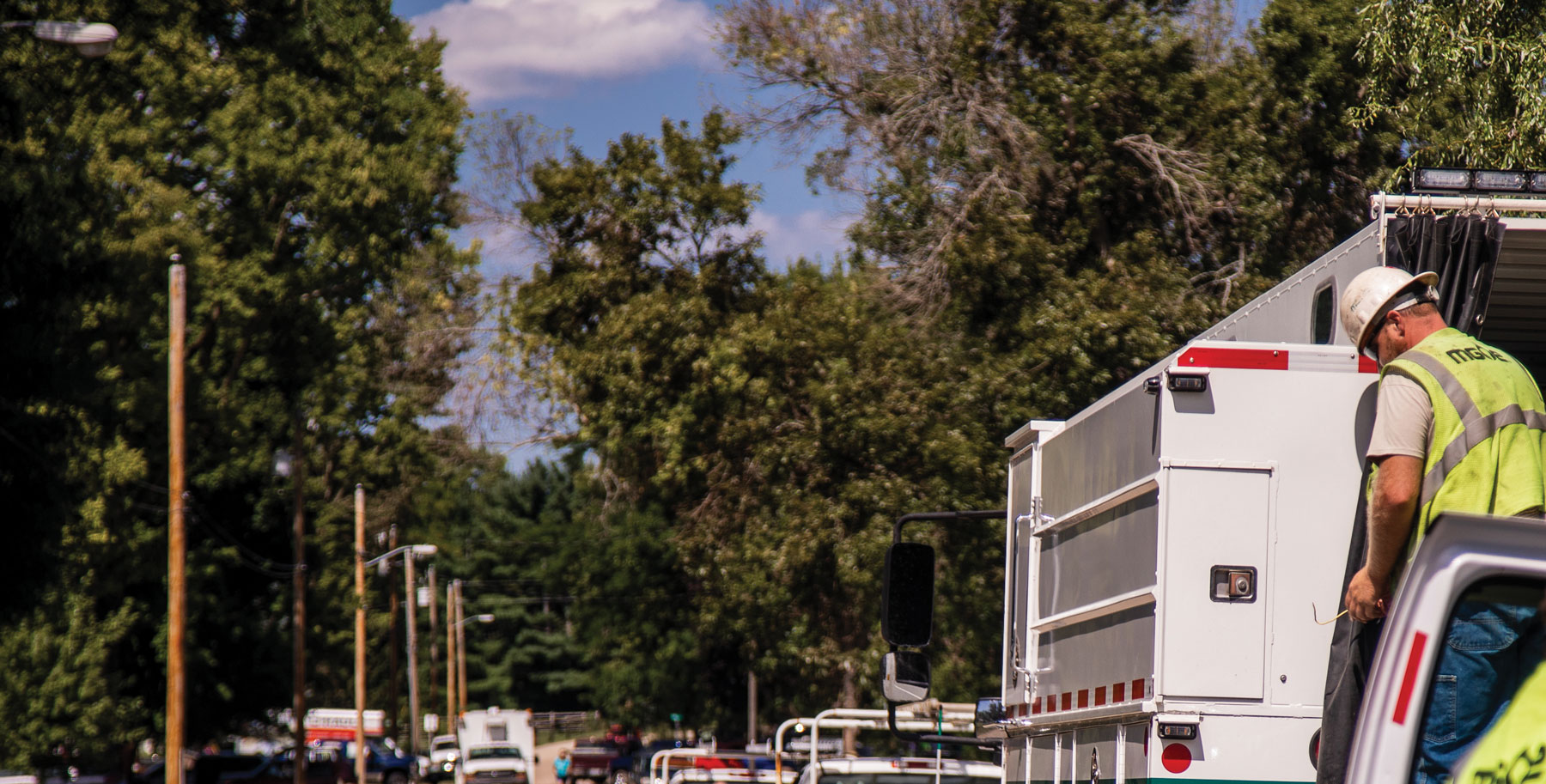
Highlights
- In 2020, MGE employees achieved historic safety results. Despite working through a global pandemic, we recorded our lowest-ever recordable incident rate.
- We received the 2020 Industry Leader in Accident Prevention Award from the American Gas Association for being an industry leader in employee safety.
- MGE was recognized by the Wisconsin Safety Council with the 2020 Wisconsin Corporate Safety Award for achieving excellence in safety and health management.
- Our Gas Construction and Operations and Division Operations teams worked a total of 118,197 hours in 2020 without an OSHA recordable or lost-time event.
- OSHA recordable injuries at MGE continue to decline companywide, decreasing by more than 60% throughout the last five years.
- When notified of a potential natural gas emergency, MGE crews continue to earn high marks. In 2020, our total response time ranked in the top 12% of a nationwide industry survey.
- In 2021, MGE earned the Green Master designation for the eighth consecutive year from the Wisconsin Sustainable Business Council. Only the top 20% of applying companies receive the Green Master designation.
- Our primary goal under our expanded contract with the Wisconsin Department of Natural Resources for Green Tier certification is to cover all MGE operations under our Environmental Management System (EMS).
Safety is a core value at MGE and it is embraced by our employees. When it comes to safety, every person and every company can always improve upon their safety performance. That is why we embrace a philosophy of continuous improvement.
We Power Safety
In 2014, MGE launched a corporate safety initiative to improve our safety culture and our journey to safety excellence. Our Safety Steering Team meets bimonthly to examine safety topics and to identify and to prioritize continuous improvement opportunities.
Our employees have taken the lead through their continuous improvement efforts to make MGE an even safer place to work. Our employee-led Continuous Improvement Safety Teams (CI Teams) are one example.
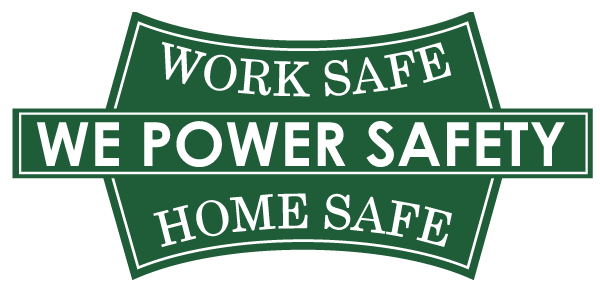
MGE’s safety vision statement was developed by one of our employee-led CI Teams. The team drafted a statement of safety values that encompasses the business of MGE and creates a positive message that all MGE employees can adopt:
As MGE employees, we power our own safety and the safety of those we work with to ensure everyone goes home safely. Our goal is zero injuries. Every day. Everywhere.
Our safety vision statement—we power safety—is highly visible throughout our organization.
In 2020, our employees achieved historic safety results. Despite working through a global pandemic, we recorded our lowest-ever recordable incident rate of 1.17, topping our previous record from 2019. A recordable incident is an event where the injury typically requires a level of care beyond basic first aid. Total recordable incident rate is figured on a per-100-employee average.
In 2020, we recorded our third-lowest lost-time incident rate since we started keeping records in 1971. Our two lowest incident rates occurred in 2018 and 2019. A lost-time event is when the employee is unable to perform his or her job because of the injury and must stay away from work to recover. Total lost-time incident rates also are figured on a per-100-employee average.
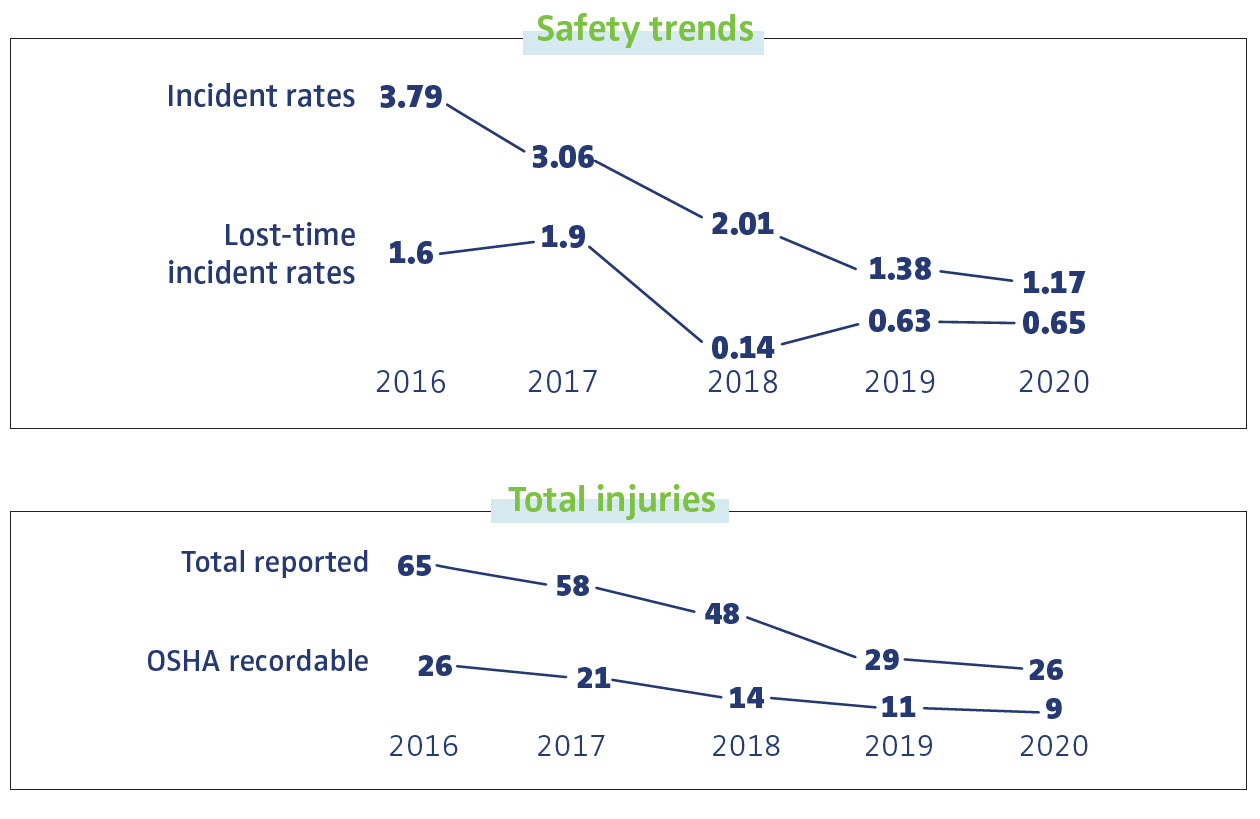
Our Gas Construction and Operations and Division Operations teams worked the entire year without a recordable or lost-time event. Employees worked a total of 118,197 hours in 2020 without an event. Building on that momentum, the Gas Construction and Operations team marked two years without a recordable or lost-time event in July 2021. Our Division Operations teams have not experienced a lost-time event in more than five years. MGE has had no work-related fatalities companywide, for both employees and contractors, since 2003.
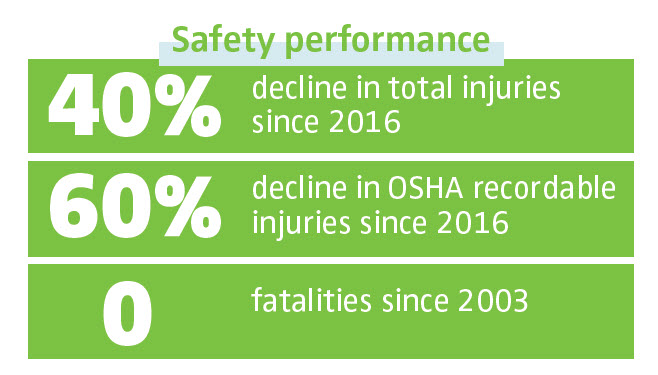
Total injuries reported continue to decline companywide, decreasing 40% throughout the last five years. OSHA recordable injuries also continue to decline companywide, decreasing more than 60% throughout the last five years.
Safety awards
In spring 2021, MGE received the Wisconsin Safety Council’s 2020 Wisconsin Corporate Safety Award. The award honors leaders in the state’s business community for achieving excellence in safety and health management. The selection committee reviewed statistical data relating to incident rates for the previous three years and health and safety in MGE’s workplace.
The 2020 Industry Leader in Accident Prevention Award from the American Gas Association recognizes companies for being an industry leader in employee safety as measured by their DART incident rates. DART stands for days away from work, restricted or transferred. In 2020, MGE had a DART incident rate below the natural gas industry average in the Small Combination Company category.
MGE’s DART incident rate has remained consistent in recent years at 0.88 and 0.78 in 2019 and 2020, respectively.
Safety perception survey
The Safety Steering Team participated in eight hours of training facilitated by Caterpillar Safety Services and discussed safety continuous improvement priorities for 2021. One of those priorities was to conduct our fourth employee Safety Perception Survey, which we completed in early 2021. This tool helps us gauge our strengths and prioritize opportunities for safety improvement. MGE increased scores across all levels (employee, supervisor, manager) since 2018 when the last survey was conducted. Since 2014, MGE’s composite score has increased by 9.4%.
Continuous Improvement Teams
Enhanced safety protocols related to our COVID-19 response interrupted CI Team planning in 2020; however, late in the year, CI Team 9, which began its work prior to the pandemic, resumed its focus on hazardous energy control in Energy Production. The Hazardous Energy Control Team identified an improvement opportunity and is finalizing the new procedure, which incorporates the application of both locking out and tagging out the equipment. The team is training the department on this new safety improvement.
Near-miss/good catch
MGE’s near-miss/good catch reporting process continues to be successful. This proactive process, developed by an employee-led CI Team in 2017, is designed to encourage reporting that identifies, documents, addresses and allows everyone to learn from the reports. The reporting process establishes accountability at all levels of the company to ensure it is implemented in a safe, no-blame environment.
In four years of using the process, more than 180 near-miss/good catch reports have been filed. Sharing reports with employees is designed to help all employees learn about safety issues and to help prevent incidents.
Proactive safety observations
Our Safety Proactive Observation Team, an employee-led CI Team in 2018, developed a process that provides employees with recognition of positive behaviors. While many companies stopped performing safety observations in the field during the COVID-19 pandemic, we remained committed to our safety goals and conducted more than 200 on-the-job safety observations in 2020—allowing employees in the field to experience firsthand that our commitment to safety remains a top priority. By the end of 2020, all operations employees experienced at least one proactive safety observation.
Since 2018, employees have recorded more than 550 proactive safety observations.
Employee wellness
MGE offers employees a comprehensive wellness program. Healthy Rewards includes exercise classes led by professional instructors; a fitness room with exercise equipment; educational sessions on nutrition, wellness, weight control and smoking cessation; expertise available from the Mayo Clinic through the managewell.com website; biometric screenings; health assessments; and annual flu shots. These offerings promote healthy living for our employees. During the COVID-19 pandemic, wellness classes and sessions are being offered to employees virtually.
More employees continue to value health and wellness opportunities. In 2020, 50% of employees registered and tracked their progress on managewell.com, up from 35% in 2016.
Preventing sprains and strains
MGE supports employees through a partnership with Briotix Health, a workplace injury prevention sports medicine provider that employs athletic trainers. This partnership was launched to address sprain and strain prevention proactively and before medical treatment becomes necessary.
We recognize that our operations employees are industrial athletes. Like professional athletes, operations employees need the highest level of support and care.
Our trainers can help with early intervention to minimize and even eliminate those injuries. The program includes MGE’s office employees too.
As a result of this partnership, sprain and strain injuries requiring medical treatment have fallen dramatically. It’s a positive program for employees and the company, reducing injuries and producing savings in the workers’ compensation fund.
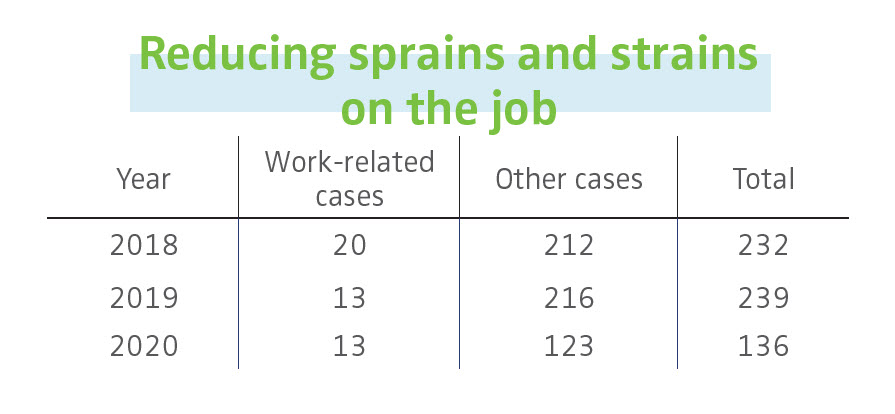
All hazards response
Whether it’s a natural disaster or a man-made disaster, MGE has plans in place to prevent and mitigate damage and ensure safety. Having a well-defined and practiced All Hazards Response Plan (AHRP) is critical to managing and responding appropriately to emergency situations. MGE’s AHRP encompasses everything from storm response to cyberattacks.
Storm Response Plan
MGE takes seriously the risk from severe weather. We have a companywide Storm Response Plan (SRP), which serves as our guide or framework for rapid, effective response to emergencies caused by extreme weather events.
Mutual assistance
MGE crews provide mutual assistance following storms affecting others. In August 2020, storms caused widespread damage and knocked out power to hundreds of thousands of customers across parts of Nebraska, Iowa, Wisconsin, Illinois, Indiana and Michigan. MGE sent 11 members of our Electric Construction and Operations team to help with storm restoration in Illinois and Iowa.
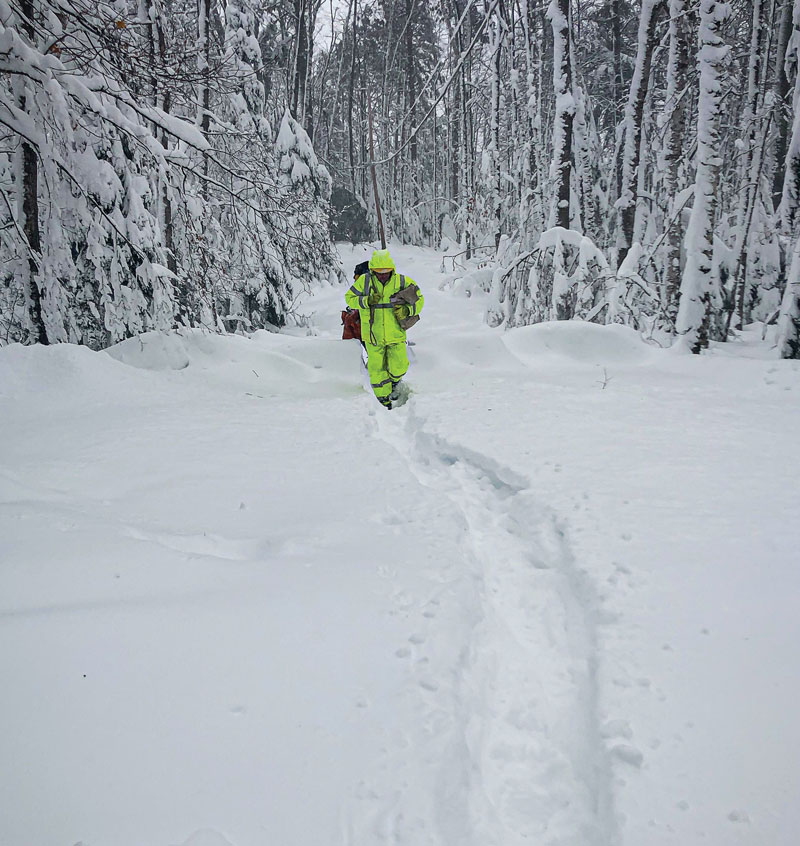
In early February 2021, five members of MGE’s Electric Operations Network team traveled to New York City to assist with restoration efforts from flooding and salt contamination in its underground electric network system. This was the first time MGE had been asked to provide mutual assistance specifically for a network system and the first time members of our Network group had gone on a mutual assistance trip.
Disaster recovery planning
MGE is committed to meeting customers’ energy needs on a typical day as well as during a storm, natural disaster or cyberattack. We review and update our disaster recovery strategies to help ensure safe and efficient business continuity during challenging times.
MGE held a full-day disaster recovery planning exercise in March 2021, simulating a severe storm impacting most of southern Wisconsin. The exercise tested aspects of MGE’s response that would only be needed under the most dire circumstances. In most storms, there is only a small potential for environmental impacts with one or two transformers spilling a small amount of mineral oil—and it is handled as part of normal operations. In this exercise, we tested plans for the transition to a large environmental response to deal with large numbers of transformers spilling oil.
We are integrating environmental response plans into our AHRP. This helps us more effectively initiate these plans and ensure environmental protection is a priority in all response actions.
Incident Command Structure activated during COVID-19
The Incident Command Structure (ICS), which is the basis for all responses under the AHRP, was activated early in MGE’s COVID-19 response in 2020. The ICS coordinated the diverse aspects of our response to ensure measures were in place to minimize COVID-19 exposure by MGE employees. By mid-March 2020, the MGE lobby was closed, employee access was restricted to certain areas in various facilities, additional daily cleaning occurred at all MGE facilities and many employees began working from home. By following our safety guidelines, we worked more than 1.5 million hours in 2020 without a single work-related COVID-19 case.
Our AHRP Operations section collaborated with other Wisconsin utilities and the American Gas Association on safe working procedures for field employees. The Gas Construction and Operations and Safety departments developed safe practices for entering a customer’s home for a gas leak or pilot light relight. Additionally, our Logistics section, along with Facilities Management, developed contingency plans to allow us to sequester key control center staff if necessary.
Working to keep our communities safe
In addition to the safety of our employees, the safety of our customers also is a top priority. We strive to keep customers well informed about the potential dangers of electricity and natural gas and what to do in an emergency, using electric and natural gas safety advertising and information included with our bills, on our social media channels and on mge.com.
Safety in the classroom
MGE partners with schools throughout our service territory and offers a wide array of classroom lessons, including electric and natural gas safety. From materials to classroom visits to share safety tips, MGE provides important energy safety lessons to students.
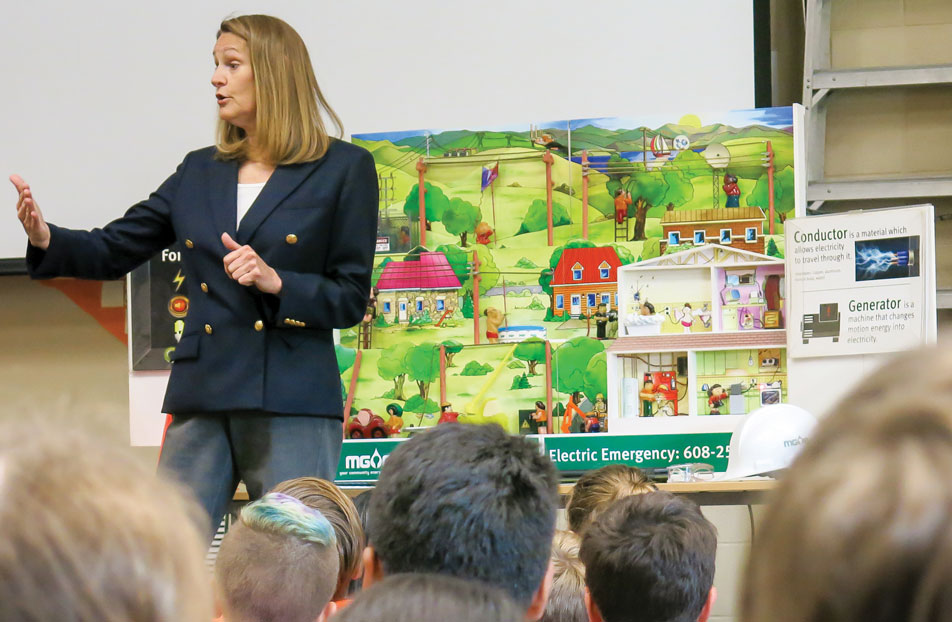
One of the most popular programs is MGE’s Switch to Safety. In addition to discussing gas safety, an MGE representative uses a tabletop electric safety model to illustrate and simulate potentially dangerous outdoor electric safety situations. During the pandemic, we reached more than 350 students with virtual safety presentations during the 2020-2021 school year.
First responder training
MGE works closely with police and firefighters who respond to emergencies within our service territory. MGE’s Electric and Gas Operations departments conduct safety training with first responders within the communities we serve.
MGE also routinely conducts drills with the Madison Fire Department at both of our Madison power plants.
Natural gas safety and sustainability
Ensuring reliability and safety are top priorities at MGE, along with protecting our environment. We are committed to continuing to provide the high level of service our customers expect.
Industry leader in emergency response
When notified of a potential natural gas emergency, MGE crews continue to earn high marks. In 2020, our total response time ranked in the top 12% of a nationwide industry survey.
This ranking is reflective of our dedicated employees who always put customer safety first and understand what it means to serve as your community energy company. It also shows what a good process MGE has in place—from when the call comes into the Customer Center to when our employees arrive on-site.
Suppliers' commitment to sustainability
MGE contracts with two natural gas transmission companies, Northern Natural and ANR Pipeline Company, owned by TC Energy.
Both of these companies, as part of their sustainability commitments, are part of the ONE Future Coalition. ONE Future is the trade name for “Our Nation’s Energy Future Coalition, Inc.” This group of more than 45 natural gas companies works together to voluntarily reduce methane emissions across the natural gas supply chain to 1% or less by 2025. In its 2020 report, ONE Future registered a methane intensity number of 0.334%, beating its 1% goal by 67%.
Northern Natural Gas and ANR Pipeline also are part of the U.S. Environmental Protection Agency’s Methane Challenge Program. Partners in this voluntary program report systemic and comprehensive actions to reduce methane emissions as part of efforts to enhance transparency in the industry. Reducing methane emissions decreases operational risk, increases efficiency and demonstrates concern for the environment, with benefits ranging from air quality improvements to conservation of non-renewable energy.
Sustainability benchmarking and partnerships
MGE is committed to reducing environmental impacts across all areas of the company. MGE voluntarily participates in statewide environmental performance programs and various industry sustainability and benchmarking groups.
Green Masters program
In 2021, MGE earned the Green Master designation for the eighth consecutive year from the Wisconsin Sustainable Business Council. Only the top 20% of applying companies receive the Green Master designation.

The independent, points-based benchmarking program evaluates applicants in nine key areas: energy, climate change, water, waste, transportation, supply chain, community outreach, workforce and governance. MGE was the first utility to be awarded the distinction in 2014.
Energy Sustainability Interest Group
MGE partners with the Electric Power Research Institute (EPRI) in a number of areas, including the Energy Sustainability Interest Group (ESIG). The largest sustainability-focused group of its kind in the electric power industry, ESIG:
- Provides a collaborative industry forum for electric power companies to discuss sustainability issues.
- Conducts focused technical research and develops specific tools to support sustainability program development.
- Tackles the challenge of identifying and understanding sustainability issues, goals, metrics and disclosure.
- Facilitates stakeholder engagement.
- Informs sustainability reporting initiatives.
ESIG projects focus on priority issues, goals, metrics and sustainability communication for the electric power industry and its stakeholders. The project work may be utilized by group members to inform the development of their own sustainability programs and initiatives. Launched in 2008, ESIG has more than 40 members from the electric power industry.
Sustainability benchmarking
In 2020, EPRI marked its seventh year of an ongoing effort to identify and understand metrics appropriate for benchmarking the performance of electric power companies on their priority sustainability issues. MGE has participated in this EPRI benchmarking since it began in 2014.
The Sustainability Benchmarking for Utilities project is conducted in collaboration with the previously mentioned ESIG and subject matter experts throughout EPRI. The project work is designed to advance technical research around what a sustainable electric power company looks like and how it can support the sustainable generation, delivery and utilization of electric power to customers.
Transparency and disclosure
To advance further transparency and disclosure, MGE also participates in the Edison Electric Institute’s (EEI) environmental, social and governance sustainability-related reporting template. The voluntary, industry-specific template includes both qualitative and quantitative information, such as generation and emissions data. Our EEI templates are available at mgeenergy.com/environment.
Task Force on Climate-related Financial Disclosures
Our report is organized to be consistent with the disclosure recommendations identified by the Task Force on Climate-related Financial Disclosures (TCFD) to help customers, investors and other stakeholders better understand our strategies, challenges and opportunities. The company has reviewed the TCFD recommendations, performed an analysis of its disclosures relative to the TCFD recommendations and determined that MGE’s disclosures are consistent with the TCFD guidance and recommendations.
Protecting our natural resources
MGE takes steps to protect our natural resources. This means doing our part to help improve waterways, preserve the natural beauty of our communities and protect wildlife habitats.Fund for Lake Michigan/Salt Wise Strategic Development Grant
Lake Michigan’s water is critical to Wisconsin’s future. MGE supports the Fund for Lake Michigan, which helps sustain the lake for those who depend on it. An initiative of the Fund is the Wisconsin Salt Wise Strategic Development Grant. It provides funding to help communities and regions of the state protect our waterways by becoming salt certified.
In winter, many companies and individuals use salt to combat icy sidewalks and roads; however, excess salt flows into our waterways, negatively impacting water quality. One teaspoon of salt pollutes five gallons of water, and once in the water, salt cannot be broken down. Additionally, chloride, a chemical in salt, is toxic to small aquatic life.
Oftentimes, 10 to 20 times the amount of salt needed to fully melt ice on parking lots and sidewalks is applied. That means up to 90% of the salt put down is washed away. Salt certification provided through the grant trains consumers how to calculate the amount of salt needed for an area without a lot of waste.
The Wisconsin Salt Wise Partnership spearheaded salt reduction efforts in Dane County. Madison launched the state’s first salt certification program several years ago. MGE works with a local certified salt applicator for snow removal at our facilities.
Black Earth Creek gas project
MGE took extra steps to complete a unique natural gas project in a safe and environmentally friendly manner. Two MGE gas lines were buried underground in Black Earth Creek. Flooding caused them to move above ground but still remain under water. Pipe that is exposed in the water can become damaged, so it had to be replaced.
Black Earth Creek is a high-profile Class 1 trout stream. This means it has sufficient natural reproduction to sustain populations of wild trout, at or near capacity. We took precautions to ensure we completed the project during a non-spawning period. By planning ahead, we were able to mitigate any disturbance to the area or damage to the habitat while replacing our gas pipe.
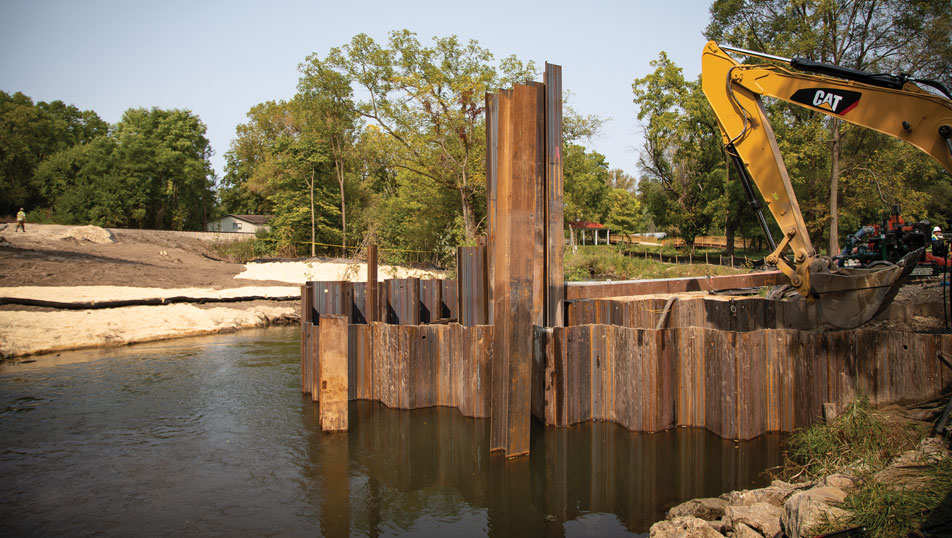
Erosion control
We are committed to implementing proper erosion control methods at all work sites. This minimizes the likelihood of soil being washed out of a site. We track permits and inspections and have a committee that reviews new regulations, field techniques and technologies to ensure we effectively manage our erosion-control strategies.
Stormwater management
Pollutants transported in stormwater are harmful to lakes, rivers, wetlands and waterways. MGE implements measures to protect our water bodies. For example, MGE’s downtown parking lot has a stormwater filtration system. This system cleans stormwater before it drains into nearby Lake Monona. This system is effective in reducing pollutants such as petroleum compounds, sediment and phosphorus.
Phosphorus reduction in local lakes
Another way MGE supports clean lakes is through Yahara WINS. This collaborative water cleanup effort began as a pilot and expanded to a 20-year program to reduce phosphorus in our watershed. MGE supports this project financially through the MGE Foundation and by serving on its technical advisory board. A collaborative approach pools the resources and expertise of community partners. It employs the strategy of watershed adaptive management in which all sources of phosphorus pollution are addressed together to meet water quality goals.
Yahara WINS is exceeding expectations for modeled phosphorus reductions. The program prevented nearly 62,000 pounds of phosphorus from reaching surface waters in 2020. This is a 45% greater reduction than the goal of 33,500.
Invasive species
Working together with MGE’s Environmental Affairs department, operations employees are trained on how to identify invasive species in MGE’s service area, plan work around them, avoid contact and follow procedures for post-work cleanup. The combination of interdepartmental coordination and formal systems for dealing with invasive species and non-native plants helps MGE stay in compliance, minimize impacts and avoid project shutdowns.
Bottle filling stations and filtration systems
Throughout our facilities, MGE has 20 water bottle filling stations and filtration systems for employees to reduce the use of plastic bottles. In the eight years since the first one was installed, MGE employees have avoided using more than 650,000 disposable plastic bottles.
Solar powers corporate office
Nearly 450 solar panels on our corporate office in Madison, Wis., generate about 10% of the energy needed annually to power the facility. The array, along with 52 panels in our visitor parking lot, represent another step in our ongoing path toward greater sustainability throughout our operations.
In addition, MGE’s 2,000-square-foot office building in Prairie du Chien, Wis., has 20 solar panels on the roof capable of producing about 5.3 kilowatts of energy.
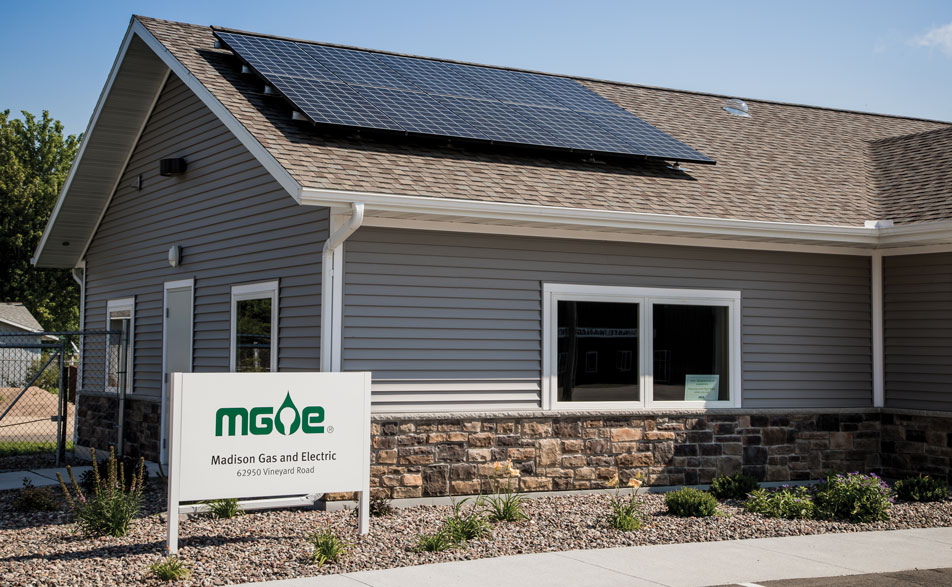
Eliminating waste with e-records
MGE’s E-records Center allows employees to submit electronic documents to be stored as records rather than keeping paper copies. Over time, this will reduce our volume of paper. This environmentally friendly option also frees up physical storage space.
Paperless billing
MGE launched My Bill Pay, an improved online billing and payment system, for customers in 2016. Online billing and payment is a “win-win” for customers and companies. Studies find customers are more satisfied when viewing and paying their bills electronically. Companies benefit by realizing paper and postage savings from not having to print and mail paper bills.
Based on the number of customer accounts signed up for paperless billing as of August 2021, more than 1.5 million bill pages are not printed each year, which saves:
- More than 3,000 reams of paper per year.
- More than 15,100 pounds, or 7.5 tons, of paper per year.
The estimated annualized savings from our paperless billing is more than $400,000.
Supply chain and waste management
Successful waste management requires a solid recycling program. We encourage employees to make smart choices about the environment. That includes supporting our recycling and waste-reduction efforts every day. We work to conserve, recycle and manage waste efficiently.
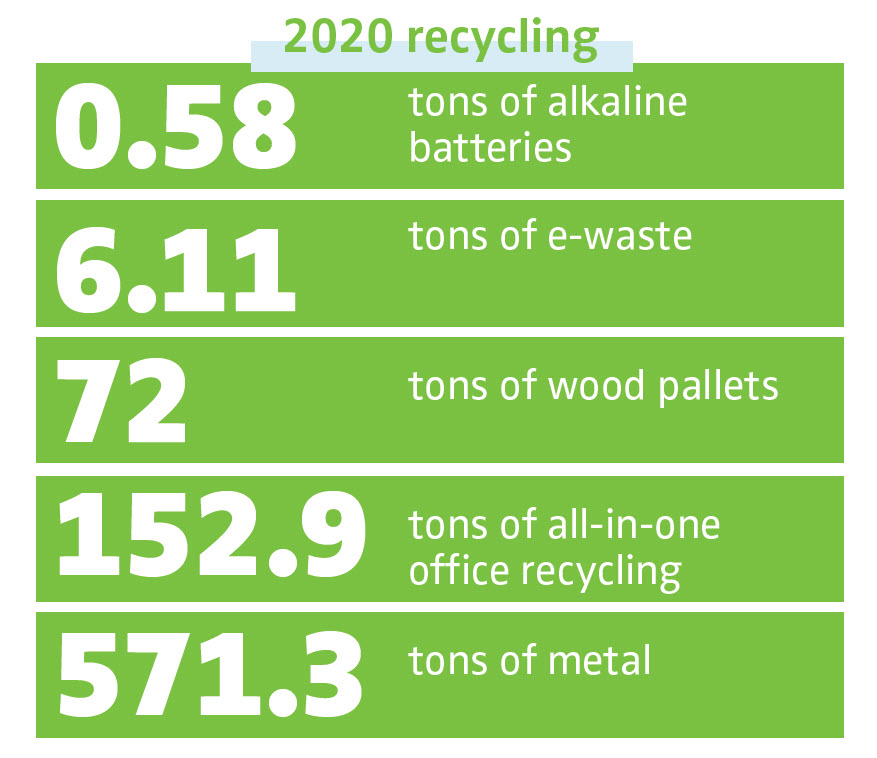
Reduce-reuse-recycle
Our all-in-one recycling method includes paper products, glass, plastic and aluminum. We also recycle various metals and other scrap materials left over from field work. Our computing equipment and supplies are sent to an e-Stewards certified company for recycling or reuse, and our alkaline batteries go to a vendor who recovers steel and zinc.
A Continuous Improvement Sustainability Team recently updated our battery recycling program. The new policy allows employees to bring in alkaline, NiCad and rechargeable batteries from home. We established collection points around the company for safe, efficient drop-offs.
We also recycle thermostats and other mercury-containing devices, chemicals, steel, iron, copper, glass and cell phones. Additionally, a local vendor takes our wood pallets, recycling them into mulch.
Environmental Management Information System
MGE’s Environmental Management Information System (EMIS), which is used to manage environmental data and processes supporting the monitoring, record-keeping and reporting associated with environmental management, marked its first full year of operation in 2020. Benefits of the EMIS include access to environmental data to support remote audits and the central tracking of recycling data and waste disposal cost savings.
Earth-friendly paint
MGE tested multiple options and is now using successfully an earth-friendly paint for marking underground gas and electric facilities.
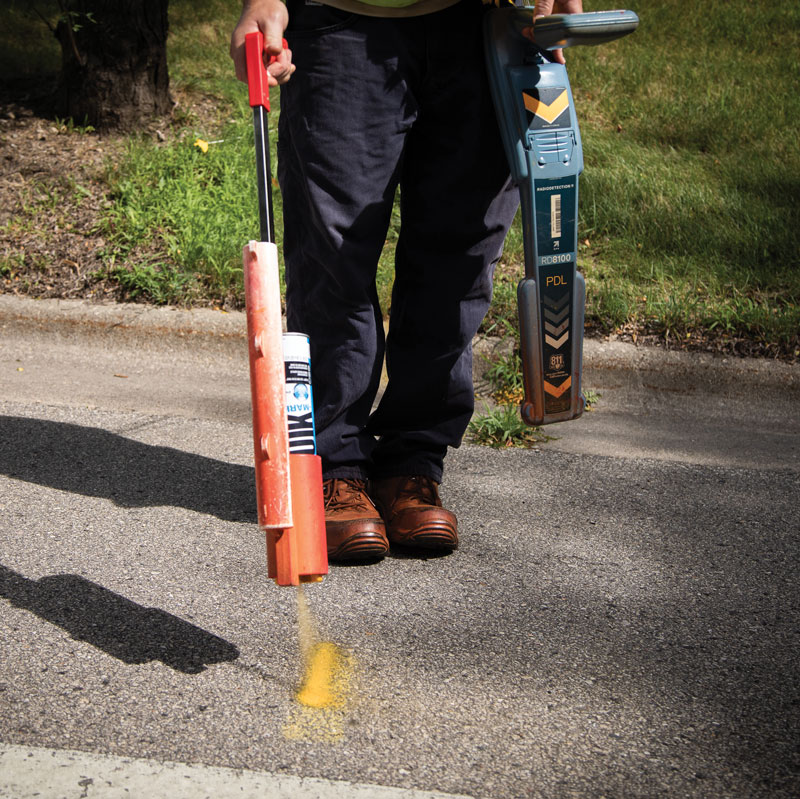
The overall design of the new paint container allows for increased recycling, a lower volume of hazardous waste and reduced disposal fees of up to $4,000 per month. Additionally, the new paint product is similar in quality to what we have used in the past and has been more consistent while marking gas and electric facilities. This translates to better efficiency for the locators in the field.
Historically, non-recyclable aerosol paint cans have been used to mark underground facilities. Aerosol cans push out the paint using a propellant, which is often hazardous. Aerosol cans also are under pressure, which causes them to be considered hazardous waste even if the paint in the can is not hazardous.
Supplier proximity and diversity
MGE is committed to supplier diversity. Our goal is to ensure that equal opportunities exist for all small businesses, women-owned businesses and minority-owned business enterprises.
MGE’s corporate policy is to buy locally. We will give preference to Wisconsin manufacturers and distributors. Local purchases support the local economy and are typically more environmentally friendly. When it is time to purchase goods needed to run our company, we review our supplier database and buy from local vendors when possible and cost-effective. Many of the materials and equipment that utilities need are highly specialized; however, we buy U.S. products whenever possible.
Comprehensive risk minimization
MGE has transitioned to a new software system for use in risk minimization. MGE’s Environmental Affairs team oversees hundreds of routine monitoring, record-keeping and reporting tasks, some of which occur every week. In the past, these were tracked on multiple servers to manage the data and deadlines as the tasks were assigned to and tracked for employees across several departments.
In 2019, MGE began using the new software, which replaced all the old servers and more with one comprehensive Environmental Management Information System (EMIS).
The new EMIS makes it significantly easier to see and track the different tasks. For example, inspections in the field are now done and saved electronically, which means the data can be retrieved instantly.
The new system provides MGE with better and quicker access to the status of compliance activities and improved information for resource planning. It also improves our reporting performance. This leads to more efficient use of time, better alignment of information management processes and simplified training for turnover or responsibility transfers.
Environmental Management System
In 2017, MGE expanded the scope of our renewed five-year contract with the Wisconsin Department of Natural Resources for Green Tier certification, which recognizes environmental leadership. Our primary goal in the expanded contract is to cover all MGE operations under our Environmental Management System (EMS). An EMS is a continuous improvement process that evaluates, prioritizes and manages environmental risks.
MGE previously used an EMS at our Blount Generating Station. The expanded scope of our EMS captures environmental improvements across the company and further demonstrates our commitment to goal-setting and environmental accountability.
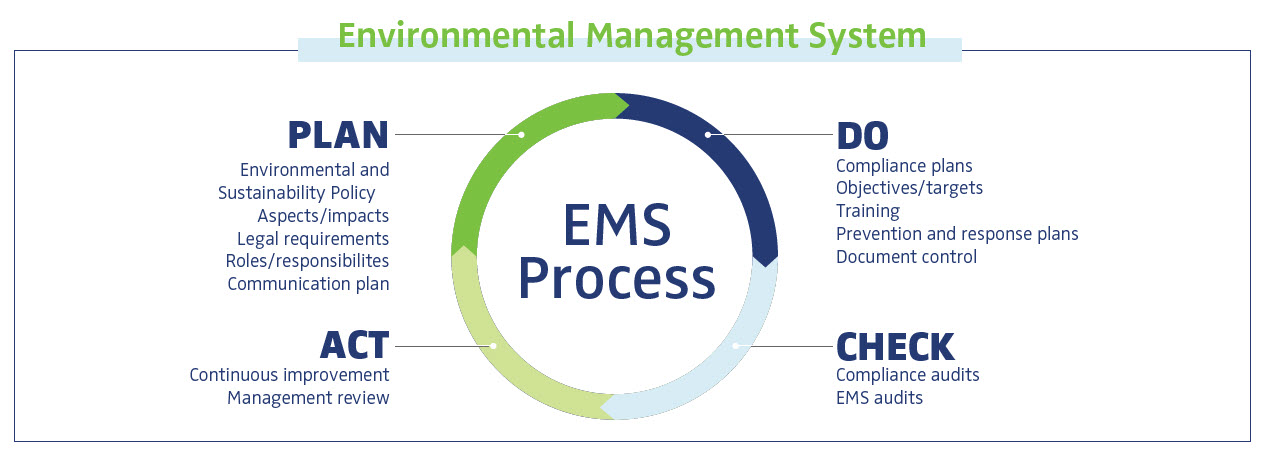
EMS goals, targets and action plans
As part of our EMS expansion, MGE’s Sustainability Steering Team developed environmental goals, targets and action plans for 2020-2021. These were informed by MGE’s Environmental and Sustainability Policy and work done by staff in our operations areas to evaluate and rank MGE’s operational environmental impacts. Progress on these initiatives includes having:
- Implemented a corporate expansion of MGE’s EMS that meets Wisconsin Green Tier requirements.
- Renewed our Green Tier contract with the Wisconsin Department of Natural Resources. Our five-year contract coincides with our recent EMS expansion and covers operations across the company. The new contract requires MGE to have an ISO-14001-equivalent EMS, an annual third-party compliance audit, a third-party audit of our EMS and development of environmental goals.
- Completed our Green Tier Year 1 third-party environmental regulatory compliance audit with facility operations being in substantive conformance with federal, state, Dane County and Madison statutes and regulations.
- Completed a third-party audit of our Green Tier EMS system with only two minor non-conformances. Auditors noted the strengths of our young system, including excellent communication and training programs; strong competency and dedication companywide; and leaders who respond to concerns, comments and ideas. As we learn from our compliance and system audits, we will continue to develop new goals and enhance our companywide EMS.
- Completed one year ahead of our five-year schedule a voluntary effort to replace 440 polychlorinated biphenyls (PCB)-contaminated transformers located around our service area. These transformers contained more than 10,000 gallons of PCB-contaminated mineral oil that we removed for proper disposal. Even as the daily workforce and priorities were restructured during the pandemic, we were able to keep the project moving forward.
- Added environmental emergencies to the corporate All Hazards Response planning process.
- Continued to convert to LED lighting at MGE facilities where feasible as well as continued energy efficiency projects during building upgrades and tracking estimated energy savings from these projects. The lighting project removed 626 fluorescent light fixtures and replaced them with 535 LED fixtures. Energy savings of 18 kilowatts will eliminate more than 30 tons of carbon dioxide emissions annually.
- Continued to implement the Fleet Alternative Vehicle Policy that evaluates new MGE vehicles when it is operationally prudent.
- Conducted a risk review of MGE’s environmental emergency response plans looking at risk to waterways, human health and sensitive environmental features.
In late 2021, the Sustainability Steering Team adopted additional goals, consistent with its commitment to continuous improvement:
- Perform an analysis of MGE’s Scope 3 emissions to inform future goal-setting related to MGE’s natural gas distribution.
- Enhance MGE’s environmental emergency response plans for the facilities with high risk to waterways, human health and sensitive environmental features.
- Evaluate MGE’s recycling and disposal options for existing MGE solar panels and wind turbine blades and develop environmental aspects to consider for future purchases of solar panels and wind turbine blades.
- Determine current pollinator friendly habitat on MGE properties and increase pollinator friendly plantings where feasible.
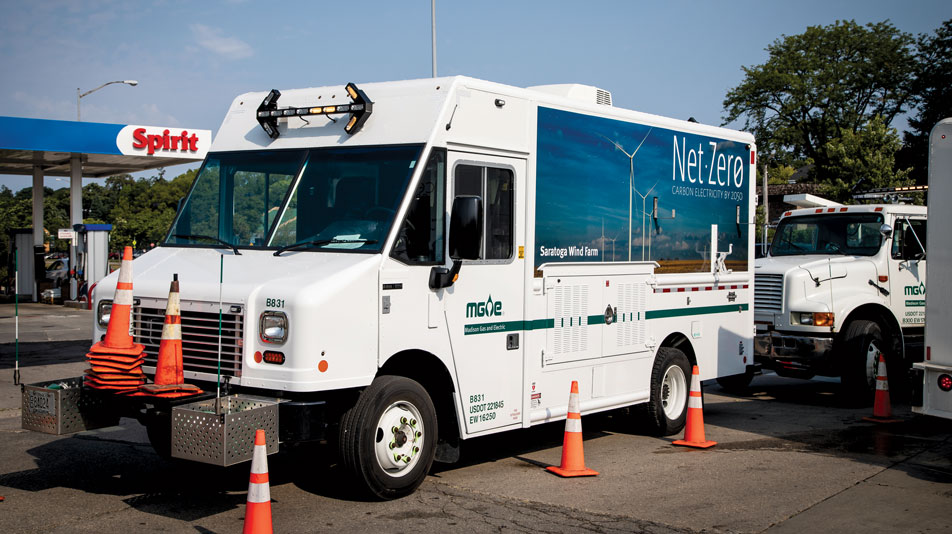 Crews working on MGE's underground electric network system in downtown Madison use this truck with battery-powered auxiliary equipment, which avoids vehicle idling while crews perform their work, helping to reduce emissions and fuel costs.
Crews working on MGE's underground electric network system in downtown Madison use this truck with battery-powered auxiliary equipment, which avoids vehicle idling while crews perform their work, helping to reduce emissions and fuel costs.